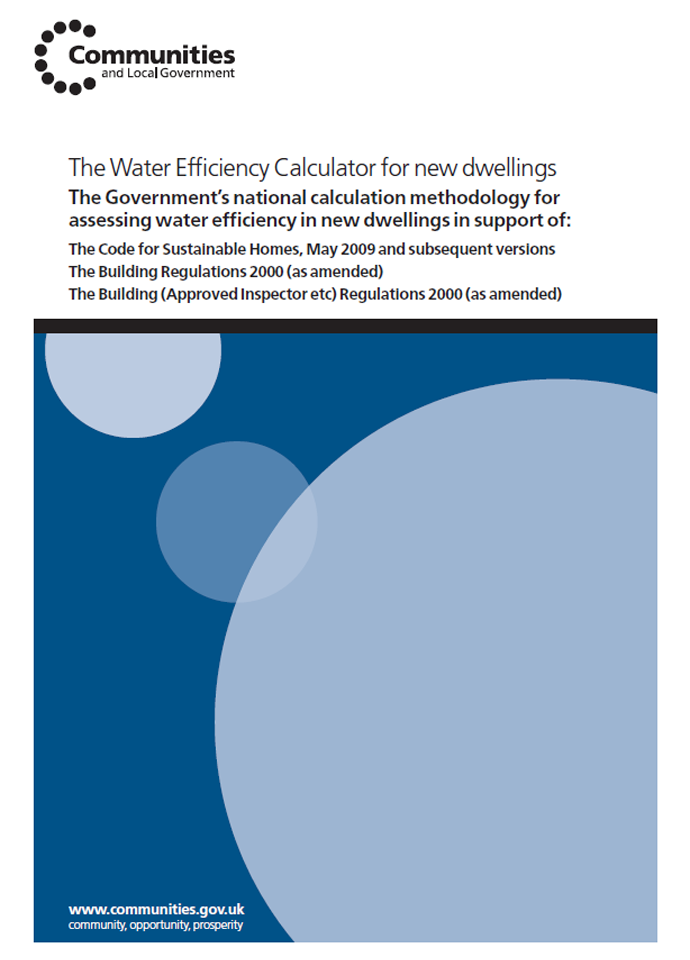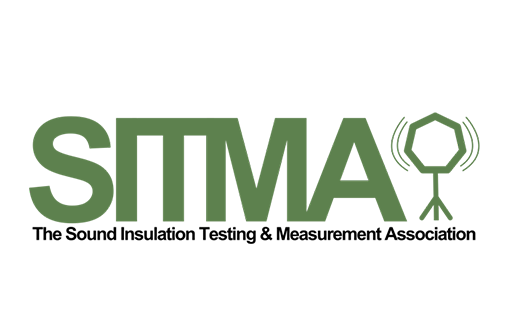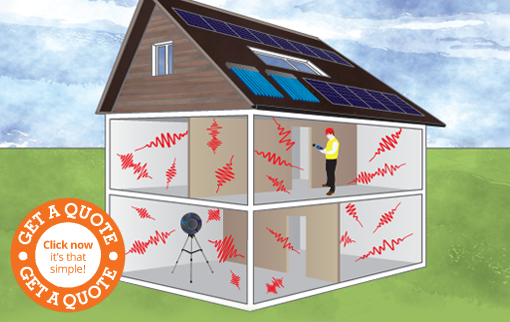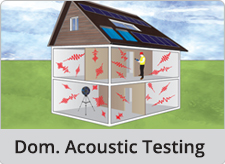Offices Nationwide

Sound Intensity
Sound intensity's measured in Decibels (dB). An logarithmic scale where an increase of 10 dB gives an apparent doubling of loudness...more

The Decibel Scale
Gives an approx of human perception of loudness. This is because the human ear has a logarithmic response to changes in sound level...more
Uxbridge - Party Floor Sound Insulation Testing - 020 3390 0301
The office that covers this area is: London
Phone Number: 020 3390 0301 Email: uxbridge@e2consultants.co.uk
Our sound testing consultants specialise in the provision of high quality and practical acoustic consultancy to both the public and private sectors in Uxbridge and the surrounding areas. Typically working with residential and commercial developers, architects, local planning authorities and environmental services.

Having been involved in building and architectural projects at all stages of development, from the specification of the external building envelope and internal separating elements, through to pre-completion testing, our expert advice has been sought after for a variety of projects. From new build, refurbished and converted developments including residential, commercial, entertainment, leisure and hotels, in addition to a wide variety of mixed-use developments.
We strongly believe that our sound testing service delivery around the Uxbridge area is second to none and that clients retain our expert services because of our continuous commitment to providing high quality and cost-effective advice.
We offer professional acoustic consultancy in Uxbridge, involving comprehensive services across all aspects of sound testing, noise measurement, assessment and control. All of our engineers are accredited sound testers under the SITMA scheme.
For a quote or more information, call one of our consultants on 'phone or email 'email
We actively encourage our Uxbridge clients to seek our services at the earliest opportunity so sound testing and the integration of any acoustic issues can feature into the overall design of a development; removing the need for costly revisions.
Building Regulations
Approved Document E in the Building Regulations is what outlines what's required when it comes to sound tests, amongst other things. There's a lot of information to take in from it but there are two main points we need to know. Firstly, it's the responsibility of the person carrying out the building work to make sure that the right sound tests are undertaken. Secondly, all new dwellings should be tested as well as buildings where the use of it is to be changed. For example, a house being converted into flats or a factory becoming a hotel.
How Many Tests Will I Need?
A set of sound tests is usually made up of six individual tests - two airborne walls, two airborne floors and two impact floors. A full set like this is required when properties, like in a block of flats, are separated fron one another by both a wall and a floor. If your dwellings are not laid out in this way then a full set will not be needed and you will only need a combination of these sets depending on how the properties are split.
Document E of Building Regulations describes how at least one test should be undertaken for every ten properties in a group. Where confusion can occur is what is meant by the term 'group' as it may not necessarily mean ten percent of all buildings.
A group relates to the type of property you'll be testing. So flats, for example, are one group and houses are another. If you have ten properties but six are houses and four are flats then you will need to test one from each group - not one from the overall pack as it may first appear. Within these groups it can get even more complicated with sub-groups relating to the type of construction used and how one property differs from the next. To avoid confusion and make sure you get the right amount of tests done first time around, we suggest giving our sound team a call on 'phone.
Here are some quick examples. A hotel with 135 rooms would need 14 full sets - one in ten separated by floors and walls. 15 terraced houses would need 2 sets of 2 airborne walls - one in ten separated by walls only.
What Can Be Tested?
Sound tests can only be done between living spaces. A study, bedroom, dining room, living room and kitchen all count as living spaces. Stairs, hallways and corridors do not count as a living area.
If there is nowhere in the property that meets this living space to living space requirement then no test is needed.
The onus is on the developer to perform pre-completion testing before the property can be 'released to market' and it is now an offence not to perform pre-completion testing.
In July 2003, the new Approved Document E 'Resistance to the Passage of Sound' (ADE 2003) of the Building Regulations came into force. This requires that new residential properties and rooms for residential purposes be tested (known as pre-completion testing) to demonstrate compliance with the explicit sound insulation performance requirements of ADE 2003.
Guidance in ADE 2003 on pre-completion testing indicates that tests should be carried out at a rate of one set of tests of each construction sub-group completed, whatever the size of the development and thereafter at least one set of tests every ten completions (assuming no failures).
We often advise property developers, contractors, housing associations and local authorities on the implications of ADE 2003. Advice is given on the materials and construction details for separating floors and walls and the key interfaces with other building elements. We also offer advice on the additional requirements of ADE 2003 including the control of reverberation in common areas and the performance of internal walls and floors. We are advising a number of clients on the practical application of RSDs as in some instances the option for construction are potentially reduced and construction costs may be significantly higher than those of a non-RSD structure.
This table shows the sets of tests required for pre-completion testing on new and converted properties:
| Property Types | Test Requirements |
Dwelling-houses Including bungalows |
Normally, one set of tests should comprise of two individual Sound Insulation Tests (SITs)(two airborne tests):1. Living room (wall) And 2.Bedroom (wall) |
Flats with separating floor but not walls |
Normally, one set of tests should comprise of four individual SITs (2 x airborne, 2 x impact): 1. Living room (airborne), 2.Living room (Impact), 3. Bedroom (airborne) and 4. Bedroom (Impact) |
Flats with separating floor and walls |
Normally, one set of tests should comprise of six individual SITs (4 x airborne, 2 x impact): 1. living room/living room (floor, airborne), 2. living room/living room (floor, impact), 3. bedroom/bedroom (floor, airborne), 4. bedroom/bedroom (floor, impact), 5. living room/living room (wall, airborne) and 6. bedroom/bedroom (wall, airborne) |
Rooms for Residential Purposes |
To conduct a set of tests, the sound insulation between the main rooms should be measured according to the principals set out above for new buildings and material change of use, but adapting them to suit the circumstances. |
Warning: count(): Parameter must be an array or an object that implements Countable in /data04/elite/public_html/Office.php on line 755
For further Party Floor Sound Insulation Testing information for your area, be sure to check out Sound-Testing-London.co.uk.
Our other services include:
Party Floor Sound Insulation Testing can also be known as:
Domestic Sound Testing HMO, Acoustic Insulation Testing, Domestic Reverberation Sound Testing, Domestic Sound Testing Hotel, Reverberation Sound Testing, Sound Testing Rooms for Residential Purposes, Party Wall Sound Testing, Party Floor Sound Testing, Domestic Party Floor Sound Testing, Sound Testing HMO, Domestic Sound Testing Rooms for Residential Purposes, Sound Testing Schools, Sound Insulation Testing, Sound Testing, Domestic Party Floor Sound Insulation Testing, Domestic Sound Insulation Testing, Domestic Sound Testing, Domestic Sound Testing Schools, Domestic Acoustic Insulation Testing, Domestic BB93 Acoustic Design of Schools, Domestic Party Wall Sound Testing, Domestic Party Wall Sound Insulation Testing, Sound Testing Hotel,


Copyright 2025 E2 Specialist Consultants Limited
Company No. 06728970










































